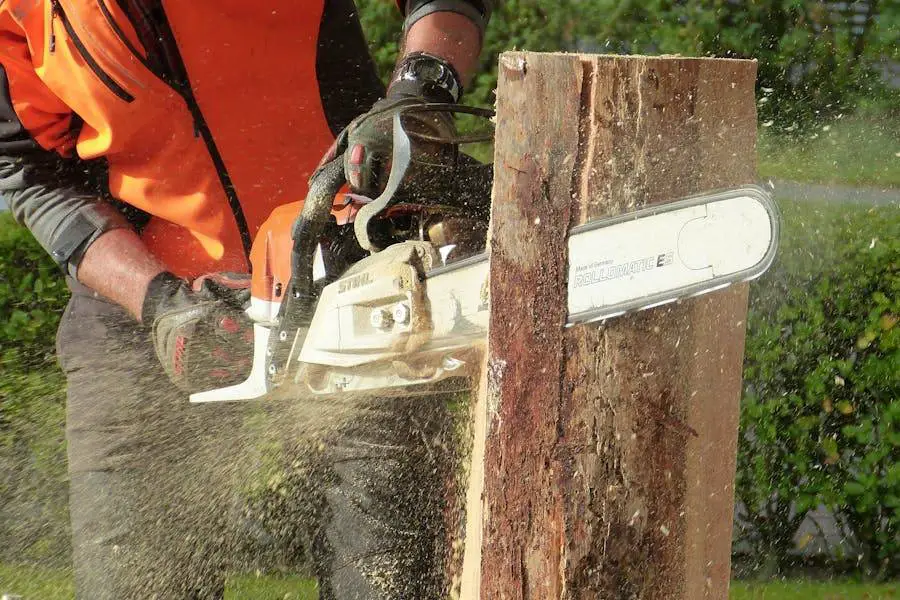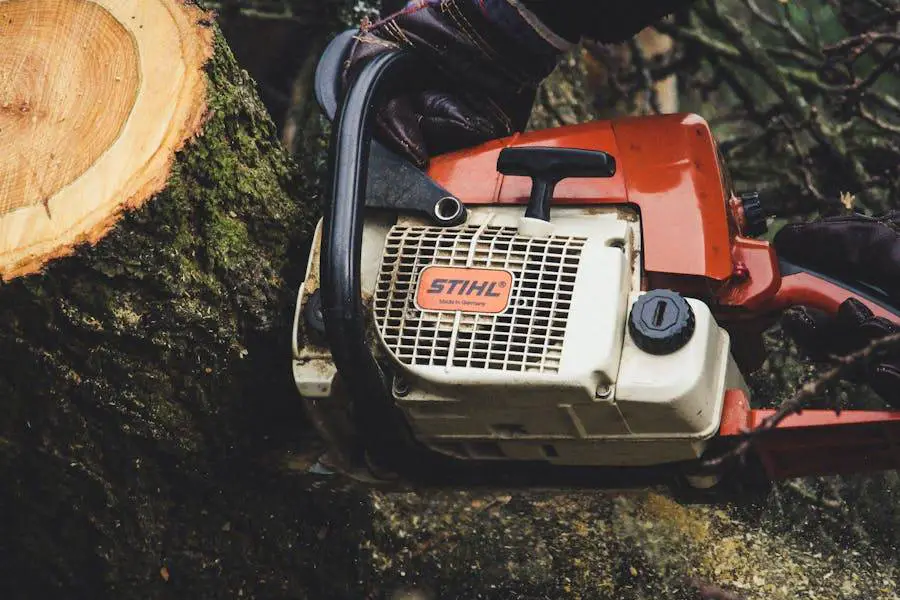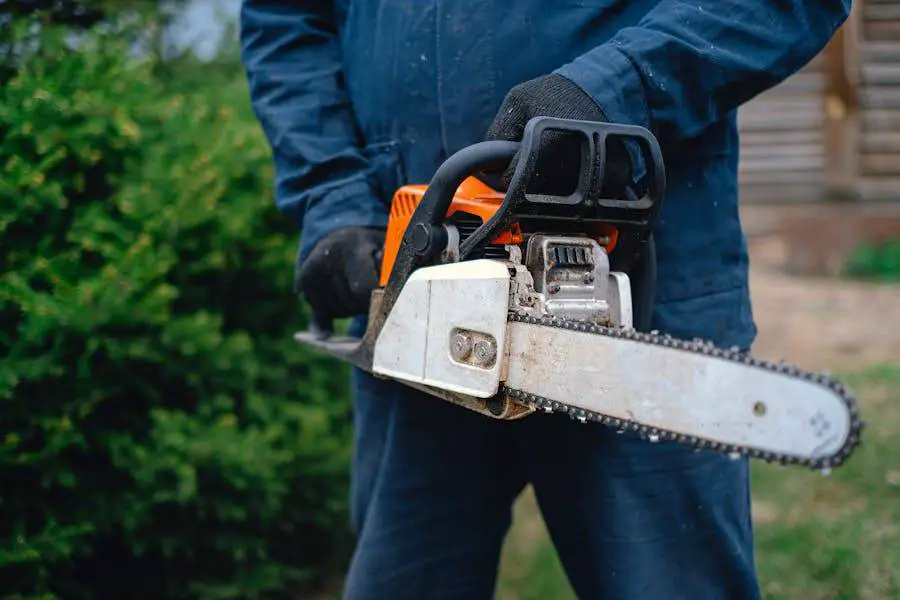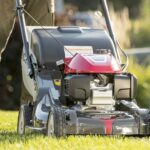Table of Contents
![]()
![]() A chainsaw is an indispensable tool for many outdoor tasks, from cutting firewood to trimming trees.
A chainsaw is an indispensable tool for many outdoor tasks, from cutting firewood to trimming trees.

However, like any mechanical device, it can sometimes be temperamental, particularly when it comes to starting after it has been running and is hot.
This issue can be frustrating and time-consuming, especially when there’s a lot of work to be done.
Understanding the causes behind why a chainsaw won’t start when hot and knowing how to address them can save time and extend the life of your chainsaw.
Understanding Chainsaw Operations
Basic Mechanics of a Chainsaw
A chainsaw operates on a two-stroke engine, which means it completes a power cycle with two strokes of the piston, combined with a crankshaft revolution.
This design allows for a high power-to-weight ratio, making chainsaws lightweight yet powerful.
The engine requires a mixture of gasoline and oil to lubricate the internal components while providing fuel for combustion.
Importance of Temperature Management
Effective temperature management is crucial for the optimal operation of a chainsaw. Both excessive heat and cold can affect performance.
When a chainsaw becomes too hot, it may struggle to start due to various factors affecting its mechanical and electrical systems.
Common Causes for Starting Issues in Hot Chainsaws
Fuel System Complications
Evaporation and Condensation within the Fuel System
When a chainsaw operates, its engine generates heat. This heat not only affects the external parts of the chainsaw but also warms up the fuel tank.
As the temperature inside the tank rises, the fuel begins to evaporate.
This creates vapor pressure within the tank, which can prevent liquid fuel from properly reaching the carburetor – a phenomenon known as vapor lock.
The risk of vapor lock increases significantly in hot weather or after prolonged use of the chainsaw without allowing it to cool.
Moreover, when the chainsaw is turned off and allowed to cool down, condensation can occur within the fuel system.
This introduces moisture into the fuel mix, which can lead to starting difficulties, as water in the fuel impedes proper combustion.
Inadequate Fuel Mixture and Its Effects
The fuel mixture for a two-stroke chainsaw engine typically consists of gasoline mixed with a specific type of oil at a certain ratio, often around 50:1 or 40:1, depending on the manufacturer’s specifications.
An incorrect mixture can drastically affect the engine’s performance and temperature.
Too much oil in the mixture increases the likelihood of carbon deposits building up in the engine and exhaust system.
These deposits can insulate heat, causing the chainsaw to run hotter than designed.
On the other hand, too little oil fails to lubricate the engine adequately, increasing friction and, consequently, heat generation.
Both scenarios can make restarting a hot chainsaw difficult, as the engine may either be too gummed up or overheated to function correctly.
Practical Solutions to Address Hot Starting Problems

Preventive Measures for Vapor Lock
Managing the temperature of your chainsaw is key to preventing vapor lock. One effective strategy is to take regular breaks during extended use to allow the chainsaw to cool down.
This not only benefits the operator by reducing fatigue but also reduces the thermal stress on the chainsaw’s engine and fuel system.
Using a fuel stabilizer can also help. These additives are designed to reduce fuel evaporation and degradation, making the fuel more resistant to the effects of heat.
Additionally, storing the chainsaw in a shaded or cool area during breaks prevents excessive heating.
If refueling is necessary, allowing the chainsaw to cool first minimizes the temperature difference between the hot engine and the cooler fuel, reducing evaporation rates.
Adjusting the Fuel Mixture for Optimal Performance
Ensuring the correct fuel-to-oil ratio is critical for the health and efficiency of the chainsaw’s engine.
Always refer to the chainsaw manufacturer’s guidelines when preparing your fuel mixture.
Use a measuring device for accuracy, and shake the mixture well before refueling to ensure the oil and gasoline are thoroughly blended.
If you’re unsure about the quality of your fuel mixture or if it has been sitting for an extended period, consider disposing of it properly and preparing a fresh batch.
Fuel that’s been stagnant for over a month can degrade, leading to poor engine performance and increased heating.
For those frequently facing hot-start issues, experimenting with different brands of two-stroke oil — some of which are specifically designed to reduce engine temperature — might offer improvements.
Ignition System Malfunctions
In the intricate workings of a chainsaw, the ignition system holds paramount importance, with the spark plug and ignition coil at its heart.
These components are indispensable for kick-starting the engine, and any malfunction here can hinder the chainsaw’s ability to start, especially when hot. A common culprit is a dirty or worn-out spark plug.
Over time, carbon deposits can accumulate on the spark plug’s electrode, impeding its ability to generate an adequate spark.
This issue is exacerbated when the chainsaw is hot, as the efficiency of electrical components tends to decrease with rising temperatures.
Moreover, the ignition coil, responsible for converting low voltage into the high voltage needed for sparking, can also succumb to heat stress.
Repeated exposure to high temperatures may lead to a breakdown of the coil’s insulation, resulting in a weak or intermittent spark that is often insufficient to ignite the fuel-air mixture in a hot engine.
Addressing these issues involves a meticulous maintenance routine. The spark plug should be inspected regularly for signs of wear or fouling and cleaned or replaced as necessary.
A clean spark plug ensures a robust and reliable spark, facilitating smooth starts. Similarly, monitoring the condition of the ignition coil is crucial.
Signs of deterioration, such as a weak, yellow spark, indicate the need for replacement.
Ensuring these components are in optimal condition helps maintain the chainsaw’s readiness for operation, irrespective of engine temperature.
Engine Running Too Lean or Low Compression

Two further intricacies that may impede the hot starting of a chainsaw include the engine running too lean or suffering from low compression.
An engine runs lean when the air-fuel mixture skews towards excess air and insufficient fuel. This imbalance can elevate engine temperatures, complicating starts when the chainsaw is already hot.
On the other end, low compression, stemming from wear and tear on internal components like piston rings and cylinders, diminishes the engine’s efficiency in compressing the fuel-air mixture, a fundamental step for ignition.
The remedy for a lean-running engine lies in the precise adjustment of the chainsaw’s carburetor.
This component regulates the ratio of air to fuel drawn into the engine, and fine-tuning its settings can rectify an improper mix.
Achieving the correct balance ensures the engine receives an optimal mixture, conducive to easy starts and efficient operation.
Conversely, addressing low compression typically necessitates a more technical approach.
It often requires a professional inspection to diagnose and rectify underlying issues such as worn piston rings or cylinder damage.
Replacing or repairing these components restores the engine’s ability to effectively compress the fuel-air mixture, thereby enhancing its readiness to start under all conditions.
Conclusion
A chainsaw that won’t start when hot can be a significant inconvenience, but understanding the potential causes and solutions can help mitigate this issue.
Regular maintenance, proper fuel mixture, and attention to the chainsaw’s cooling needs can all contribute to more reliable operation.
When in doubt, professional advice or service should be sought to ensure the longevity and performance of your chainsaw.


![Hot And Neutral Reversed But Wired Correctly [Causes + Solutions] Hot And Neutral Reversed But Wired Correctly [Causes + Solutions]](https://homesteadandprepper.com/wp-content/uploads/2022/06/Hot-And-Neutral-Are-Reversed-But-Wired-Correctly-150x150.jpg)





